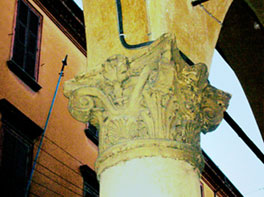|
BED AND BREAKFAST IN BOLOGNA ACCOMMODATION IN BOLOGNA ERBORISTERIA WEBMASTER |
||||||
|
|
Jakob Burckhardt the great historian of the Italian
Renaissance wrote, "Considering individual buildings, there are four or
five cities preceeding Bologna, but it is and remains the most beautiful
Italian city judged as a whole". Leaving Burckhardt with the
responsibility for the superlative, it is certain anyway that his
judgement emphasised a recognizable feature of the city, that is the
beauty of its urban plan. This means that Bologna's historic centre is
not just to be visited for one particular "splendid" feature in front of
which one is "amazed" and then departs. On the contrary, it is a
homogeneous ensemble which
has grown through the centuries by means of contrasts and new syntheses: a
unique monument. Therefore, it seems reasonable to try and explain the
story of this remarkable urban development-which coincides, essentially,
with the economic and political history of the town-especially as we have
the advantage that Bologna has, after Venice, the best preserved historic
centre in Europe. Therefore our story develops from its origin to the
present day and aims at explaining the various stages of its growth which
has produced a complex of streets, towers, buildings and monasteries, all
of them linked by portico (arcades), a long binding ribbon for a city
which has been defined as "a great basket of terracotta". In fact, with
its thirty five kilometres of porticoes Bologna has the greatest number of
porticoes in the whole world.
|
|
b u |
|||
|
General - Environment - Iron and Etruscan Age - Roman Age - Patron Saint- The Commune - Alma mater studiorum - Re Enzo - Porticoes - St Peter - Gothic - 14th Century - Piazza Maggiore - Aristocratic palaces - Brick and other stones - Early 15th Century - Archiginnasio - Counter Reformation Renaissance - 16th Century - Great portico ribbons - Frescoes in palaces - The "scenographic" city - Napoleon's republics - Fall of Church power - The Restoration - Haussmann style - The new Century - Floreal style - Rationalism - World War - Active preservation - Around 2000 |
||||||
